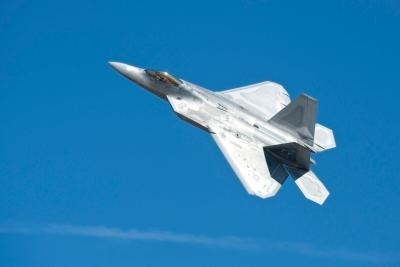Sat, Apr 06, 2013
USAF Says Modifications To Oxygen Systems Have Been Completed Across The Fleet
The F-22 Raptor has resumed normal flight operations after modifications to aircrew life-support equipment were completed across the fleet, including the upper pressure garment and related hoses, valves and connectors. Completion of this task eliminates the need to restrict flight operations to remain within a 30-minute flying distance from an airfield suitable for landing.

F-22 crews have also resumed their aerospace control alert mission in Alaska after the Automatic Back-up Oxygen System was installed in aircraft based at Joint Base Elmendorf-Richardson, Alaska. Altitude restrictions have also been incrementally removed for F-22s that have received the ABOS modification. Altitude restrictions for training flights remain for non-ABOS equipped F-22 aircraft; however, those restrictions will be removed as each aircraft is modified.
The return to normal flight operations hinged on completing eight near-term actions identified by the Air Force Scientific Advisory Board, successful fielding of the modified Combat Edge upper pressure garment valve and fielding of the automatic backup oxygen system. All actions identified by the SAB were completed in December 2012. Fielding of the modified Combat Edge upper pressure garment valve and related pieces was completed in January.
The fielding of the ABOS provides additional protection to F-22 pilots while flying at high altitudes and in the most demanding oxygen-delivery scenarios. The first combat aircraft was modified in January at Nellis AFB, NV. Elmendorf-assigned Raptors began modifications in February and officials expect combat fleet completion by July 2014.

In May 2011, Air Force officials stood-down the F-22 fleet for four months. This operational pause enabled the Air Force to accelerate efforts to study, define and fix the cause of the reported incidents. After the SAB completed its investigative actions in January 2012, the F-22 Life Support Systems Task Force formed a multiservice, multiagency team of government, industry and academic experts to review previous recommendations and findings. This increased breadth of experience, enhanced scope of knowledge, and additional impartial expert analysis led to the conclusion that a lack of oxygen quantity was causing the physiological incidents. The task force also determined the quality of oxygen was not causing the physiological symptoms reported by F-22 pilots and ground crew.
F-22 aircrews have flown more than 22,270 sorties and more than 27,500 hours since the last previously unexplained incident in March 2012. Air Force officials will continue to leverage lessons learned throughout the F-22 investigative process and will invest in characterizing and better understanding the high-performance aircraft environment to improve pilot safety and performance in the F-22 and in all current and future weapon systems.
(Images provided by the USAF)
More News
From 2023 (YouTube Version): Legacy of a Titan Robert (Bob) Anderson Hoover was a fighter pilot, test pilot, flight instructor, and air show superstar. More so, Bob Hoover was an i>[...]
Get The Latest in Aviation News NOW on Instagram Are you on Instagram yet? It's been around for a few years, quietly picking up traction mostly thanks to everybody's new obsession >[...]
Aero Linx: B-52H Stratofortress The B-52H Stratofortress is a long-range, heavy bomber that can perform a variety of missions. The bomber is capable of flying at high subsonic spee>[...]
Altimeter Setting The barometric pressure reading used to adjust a pressure altimeter for variations in existing atmospheric pressure or to the standard altimeter setting (29.92).>[...]
"Knowing that we play an active part in bettering people's lives is extremely rewarding. My team and I are very thankful for the opportunity to be here and to help in any way we ca>[...]
 Classic Aero-TV: Remembering Bob Hoover
Classic Aero-TV: Remembering Bob Hoover ANN FAQ: Follow Us On Instagram!
ANN FAQ: Follow Us On Instagram! ANN's Daily Aero-Linx (05.15.24)
ANN's Daily Aero-Linx (05.15.24) ANN's Daily Aero-Term (05.15.24):Altimeter Setting
ANN's Daily Aero-Term (05.15.24):Altimeter Setting Aero-News: Quote of the Day (05.16.24)
Aero-News: Quote of the Day (05.16.24)




